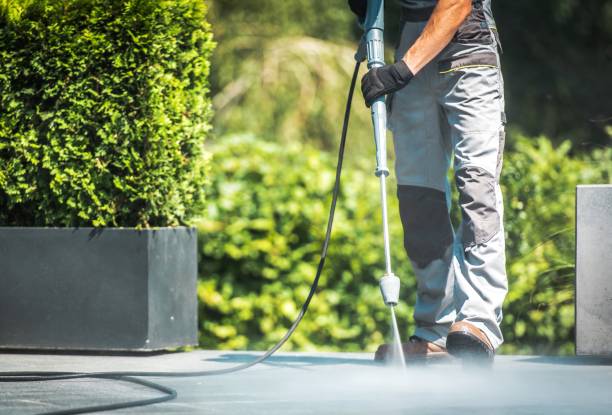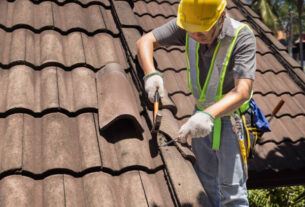Page Contents
Introduction
Spring is the perfect time to refresh your outdoor living space and get it ready for the warm months ahead. One of the best ways to spruce up your patio is by giving it a thorough power washing. In this article, we’ll cover the benefits of power washing your patio, how to choose the right power washer, and techniques for getting the job done right. Let’s dive in!
Benefits of Power Washing Your Patio
Enhances Curb Appeal
Power washing your patio can significantly improve the look of your home’s exterior. A clean, well-maintained patio not only makes your outdoor space more inviting but also boosts your property’s overall curb appeal.
Removes Dirt, Grime, and Stains
Over time, your patio can accumulate dirt, grime, and stubborn stains from spills, mold, and mildew. Power washing blasts away these unsightly blemishes, leaving your patio looking fresh and new.
Protects Against Damage
Regular power washing helps protect your patio from damage caused by dirt, mold, and mildew. It also helps prevent the growth of algae, which can make your patio slippery and hazardous.
Choosing the Right Power Washer
Electric vs. Gas Power Washers
There are two main types of power washers: electric and gas. Electric power washers are generally quieter, lighter, and easier to maintain, while gas power washers tend to be more powerful and suitable for heavy-duty jobs. Consider the size of your patio and the amount of grime you need to remove when choosing between the two.
Pressure Ratings
Power washers are rated by their pressure output in pounds per square inch (PSI). For most patio cleaning tasks, a pressure washer with a PSI rating between 2,000 and 3,000 should suffice. Higher PSI ratings are suitable for more demanding cleaning tasks, like removing paint or graffiti.
Attachments and Accessories
Various attachments and accessories are available for power washers, such as surface cleaners, turbo nozzles, and extension wands. These can help make your patio cleaning task more efficient and effective.
Preparing Your Patio for Power Washing
Clearing the Patio
Before power washing, remove all furniture, potted plants, and other items from your patio. This will give you easy access to the entire surface and prevent any accidental damage to your belongings.
Inspecting the Surface
Take a close look at your patio’s surface for any cracks, chips, or loose pavers. Repair any damage before power washing, as the high-pressure water can potentially worsen existing issues.
Pre-Treating Stains
For stubborn stains like oil or grease, pre-treat the area with a specialized cleaning solution before power washing. This will help loosen the stain and make it easier for the power washer to remove it.
Power Washing Techniques
Selecting the Right Nozzle
Power washers come with various nozzle attachments, each designed for specific tasks. For patio cleaning, use a nozzle with a 25-degree spray angle for a balance between cleaning power and surface protection. Avoid using a zero-degree nozzle, as it can damage the patio surface.
Proper Spraying Technique
Hold the power washer wand at a consistent distance from the patio surface, usually about 6 to 12 inches. Start at one end of the patio and work your way across, using slow, overlapping strokes. Make sure to maintain a consistent speed and pressure to avoid leaving streaks or unevenly cleaned areas.
Protecting Surrounding Plants and Furniture
Cover any nearby plants and outdoor furniture with a waterproof tarp or plastic sheeting to protect them from the high-pressure spray and any cleaning solutions you may use.
Post-Power Washing Tips
Drying the Patio
After power washing, allow your patio to dry completely before replacing furniture and other items. This will help prevent the growth of mold and mildew, as well as keep dirt and debris from sticking to the freshly cleaned surface.
Sealing the Surface
Consider sealing your patio’s surface after power washing, especially if it’s made of porous materials like concrete or natural stone. Sealing helps protect the surface from stains, weathering, and general wear and tear.
Conclusion
Power washing your patio is an effective and efficient way to refresh your outdoor living space and get it ready for the warm months ahead. By choosing the right power washer, preparing your patio, and using proper techniques, you can achieve a clean, inviting, and well-maintained patio that enhances your home’s curb appeal and offers a welcoming space for entertaining and relaxation.
FAQs
- How often should I power wash my patio? It’s generally recommended to power wash your patio at least once a year, preferably in the spring. However, if your patio sees heavy use or is located in an area with a lot of dust, dirt, or pollution, you may need to clean it more frequently.
- Can I use a regular garden hose to clean my patio? While a garden hose can help rinse away loose dirt and debris, it won’t have the same cleaning power as a pressure washer. Power washing is much more effective at removing stubborn grime and stains from your patio’s surface.
- Is power washing safe for all patio materials? Power washing is safe for most patio materials, including concrete, brick, and natural stone. However, some materials, like wood, may require a lower pressure setting to avoid damage. Always consult the manufacturer’s recommendations for your specific patio material.
- What should I do if my patio has significant damage, like large cracks or loose pavers? In cases of significant damage, it’s best to consult a professional for repair or replacement before power washing. Power washing can exacerbate existing damage and even create new issues if not done correctly.
- Can I power wash my patio furniture as well? Yes, power washing can be an effective way to clean outdoor furniture. However, use caution and a lower pressure setting for delicate materials like wicker or fabric cushions.

Lois Lane is a professional blogger and a seasoned Content writer for wellhousekeeping.com. With a passion for simplifying complex Home Decor topics, he provides valuable insights to a diverse online audience. With four years of experience, Lois has polished his skills as a professional blogger.




